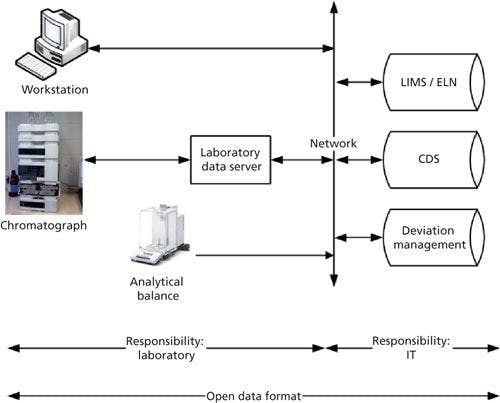The 2016 LCGC Awards
LCGC North America
The winner’s of LCGC’s 9th annual awards are highlighted
The winner’s of LCGC’s ninth annual awards are highlighted.
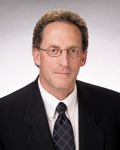
Milton L. Lee

Debby Mangelings
The LCGC Awards have made their mark in chromatography history during the last eight years by honoring the work of iconic figures in the field as well as up-and-coming scientists (Table I). In 2015, we had the opportunity to go a step further by honoring the award winners at an oral symposium as part of the Pittcon 2015 technical program, featuring talks by both of the award winners and Mark R. Schure, Lloyd R. Snyder, and Terry A. Berger. The winners of the ninth annual LCGC awards also will be honored at Pittcon 2016.
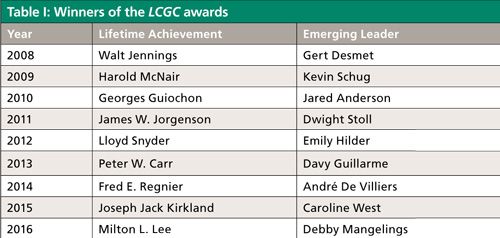
This year, we are pleased to honor two outstanding separation scientists: Milton L. Lee, the winner of the 2016 Lifetime Achievement in Chromatography Award, and Debby Mangelings, the winner of the 2016 Emerging Leader in Chromatography Award. Lee and Mangelings will receive their awards on Monday, March 7, during an oral symposium at Pittcon 2016 in Atlanta, Georgia.
Milton L. Lee
Milton L. Lee graduated from the University of Utah in 1971 with a B.A. in chemistry. From there, he went on to receive his PhD in analytical chemistry in 1975 from Indiana University under the guidance of Milos V. Novotny.
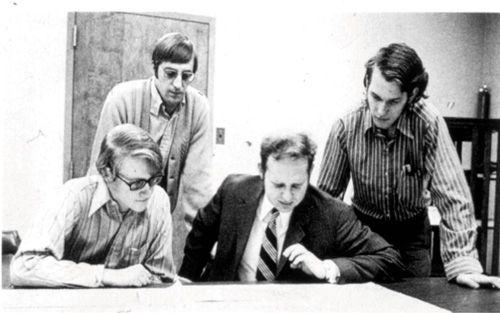
Evaluating some complex chromatograms obtained through capillary GC in 1973 at Indiana University (IU). From left to right: Doctoral students, Mike McConnell and Milton Lee, Dr. Milos Novotny, and an IU sophomore Raleigh Farlow. The photo secured through the courtesy of Department of Chemistry, Indiana University.
“I have been very fortunate to have many great graduate and postdoctoral students during my career,” said Novotny, now a Distinguished Professor Emeritus at Indiana University. “Milton was one of the best.” He was also Novotny’s first. Novotny explained that the two began their work together on several aspects of capillary chromatography and that Lee was “enormously helpful” in starting his research laboratory. Lee was also able to get his PhD in four years with a high number of publications, Novotny noted. “This was because he rapidly learned the experimental skills and knowledge of chromatography and became incredibly motivated and organized in his research,” said Novotny.

Milton Lee working in the Novotny Laboratory at Indiana University in 1975.
After receiving his PhD, Lee briefly worked as a chemical engineering research associate at the Massachusetts Institute of Technology under Ronald A. Hites. In 1976, he took an assistant professor position in the Department of Chemistry and Biochemistry at Brigham Young University (BYU) in Provo, Utah, a position he held until 1981. Lee was an associate professor at BYU from 1981 to 1984, and then in 1984 he became a full professor. In 1985, Lee was named the H. Tracy Hall Professor of Chemistry at BYU, which is his current position.
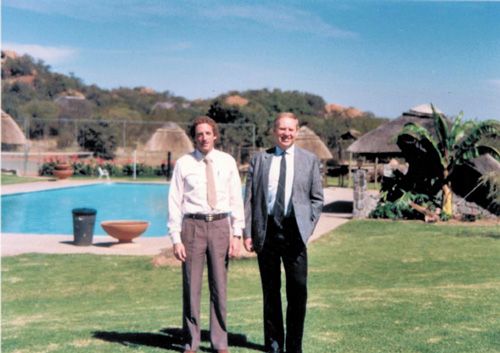
Lee and Novotny during a lecture tour in South Africa in 1988.
Lee: A Scientist in Motion
Lee is known for a wide range of achievements. In addition to his research and teaching at BYU and his work advancing capillary chromatography, electrophoresis, and other techniques, Lee obtained 20 patents and successfully commercialized three instruments. He also founded three analytical instrument companies (Lee Scientific, Sensar, and Torion) as well as one journal (Journal of Microcolumn Separations). In addition, he has published more than 570 journal articles and given more than 500 presentations.

Lee in a BYU department graduate student recruiting brochure from 1982.
We interviewed several of Lee’s colleagues, friends, and former students about his achievements, impact, and relationships. One common theme was that Lee’s abilities and work have been wide-ranging, making it difficult to name a single greatest contribution to the field.
“When you look back on Lee’s body of work in separations, he has continued to transform himself and his expertise,” said Mary Ellen P. McNally, a Technical Fellow at Dupont Crop Protection. She explained that Lee’s work focused on a wide range of techniques, including supercritical fluid chromatography (SFC), electric field gradient focusing of proteins, high-speed thermal gradient gas chromatography (GC), polymer monolithic column technology for liquid chromatography (LC), sampling and concentration of target organic compounds in air, thermochemolysis–methylation of microorganisms for the generation of characteristic biomarkers, toroidal ion trap mass spectrometry (MS), and fluidic sieving of nanoparticles.
Former graduate school labmate and long-time friend James Jorgenson, the Kenan Professor of Chemistry at the University of North Carolina at Chapel Hill, agreed. “Lee has worked on so many divergent things, from analyzing tobacco smoke, SFC, and the design of mass spectrometers to monolithic LC columns, and the list goes on and on,” he said.
“He is a giant in separation science with an endless list of accomplishments,” echoed Jim Luong, Associate Technology Director with the The Dow Chemical Company. “What is unique about Milton is that he is a scientist in motion-he continues to invent and to drive science forward!”
Pat Sandra, an emeritus professor at the Research Institute for Chromatography, agreed that Lee has significantly contributed to many fields of separation science. “His portable analyzers are definitely some of the highlights of his achievements,” he added.
Theory and Practice
But it is not just Lee’s breadth that is remarkable. It is his ability to connect the diverse areas of his work. Lee’s research philosophy is unique in the way that fundamental chemistry, physics, biology, and mathematics are intertwined with the corresponding applied sciences and technology, noted one of Lee’s postdoctoral researchers, Karin Markides, now the senior advisor to the president and CEO of Chalmers University of Technology. “In this way, theory and practice meet in a most stimulating way to enhance the ability to sample, separate, and detect valuable chemical information,” she said. “His ability to spin out chemical instrumentation of high complexity to the market and at the same time continue as a leading researcher and teacher is an amazing achievement. The impact of his career is too large to measure.”
Former student and colleague Bruce E. Richter, an R&D manager at Agilent Technologies, agreed that Lee is impressive in his ability to connect theory and practice. “While Lee understands the theories, his approach has always been to develop practical solutions for real problems,” he said. “Whether the technique was GC, SFC, LC, or capillary electrophoresis (CE), Lee helped to improve the ability of these techniques to solve real problems by providing new tools and insights that demonstrated higher levels of practicality and usability.”
As an example, Richter cited Lee’s work to develop a better understanding of surface deactivation of fused-silica capillaries and then new and innovative stationary phases all for GC. “Lee has always pushed the envelope of separation science by looking at what problems existed and trying to develop ways of overcoming those problems,” he concluded.
As a result, noted Edward Yeung, a Distinguished Professor Emeritus at Iowa State University, Lee has had a significant impact on separation science. “Lee’s work has not only conceptually changed separation science, but also has had a major influence on the users of separation science,” he said. “This is evident from the many patents that are derived from his work and the different companies that Lee founded to adapt his inventions to practical applications.”
Lee’s influence on instrumentation goes beyond his specific developments, said Markides. “The significance that Lee always gave to the separation part of the analysis and [his insistence] that the column is the most important component of separations instrumentation has strongly influenced the way that instrument companies care for sample separation and transfer to detection,” she said. “This emphasis on separation has been crucial for the successful development of the whole area of microfluidic separations.”
While Lee’s impact in the separations science community has been felt on the industry side, many consider his academic contributions to be his biggest legacy. “Lee spread his knowledge by training around 100 graduate students in his career,” said Pankaj Aggarwal, a senior scientist at Pfizer and a former graduate student of Lee’s.
Another former student of Lee’s, Sheldon Sumpter, who is an operations and program manager at DuPont Crop Protection, agreed with Aggarwal. “Lee’s greatest contributions to the field of separation science are his graduate students and post docs,” he said.
Luong also mentioned Lee’s contributions in academia. “Lee is an incredible educator and a lifelong learner himself,” he said.
Jorgenson agreed. “I suppose in the end, as with many people working in universities, Lee’s greatest contribution will be all of the students he has introduced to the field of separations,” he said.
In the Broader Community
Lee has also been very active with analytical chemistry journals. In addition to founding and editing the Journal of Microcolumn Separations, Lee has been on the editorial advisory boards of 12 different publications at various times during his career. Some of those include Chromatographia (1981–2006), LCGC (1985–1987), Journal of Supercritical Fluids (1988–1999), Polycyclic Aromatic Compounds (1989–2002), Analytical and Bioanalytical Chemistry (1999–2003), and Analytical Methods (2012–present).
In addition, Lee has been involved with several scientific organizing committees over the years. From 1983 to present, Lee has been on the scientific organizing committee for the International Symposia on Capillary Chromatography. Lee was also on the scientific organizing committee for the International Symposia on Microcolumn Separations from 1987 to 1990, and the chairman of the organizing committee for the International Symposia on Supercritical Fluid Chromatography from 1987 to 1991. Finally, Lee was the chairman of the organizing committee for the International Symposia on Capillary Chromatography and Electrophoresis from 1995 to 2005. Lee is currently on the International Advisory Board of Mediterranean Separations Science Foundation Research and Training Center, which he joined in 2005.
Numerous Awards
Over the course of his illustrious career, Lee has been the recipient of 35 awards. Some of those awards include the First Annual Governor’s Medal for Science and Technology, State of Utah (1987); the American Chemical Society (ACS) Award in Chromatography (1988); the Russian Tswett Chromatography Medal (1992); the Martin Gold Medal (1996); the Karl D. Maeser Distinguished Faculty Lecturer Award, BYU (1998); the Dal Nogare Award (1999); The California Separation Science Society (CASSS) Award for Distinguished Contributions to Separation Science (2005); the Pittsburgh Analytical Chemistry Award (2008); and the LCGC Europe Lifetime Achievement Award (2014).
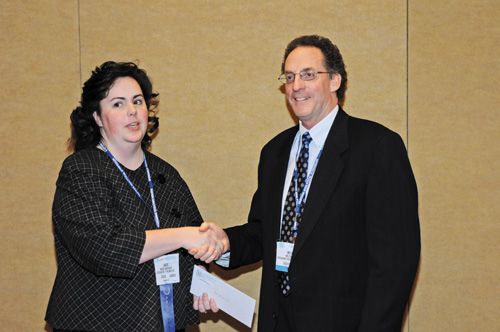
Kate Jackson, 2008 EAS President, presenting Milton Lee with the 2008 Eastern Analytical Award for Contributions to the Fields of Analytical Chemistry. The Fields Award is the top award given at the EAS conference. (Photo courtesy of EAS.)
A Teacher’s Legacy
As indicated earlier, Lee has played a significant role in the lives of a large number of students who have gone on to achieve great success in analytical chemistry and related fields. To date, Lee has mentored 62 PhD students, 26 post-doctoral researchers, and eight MS students.
Markides said that Lee inspired his students, partly through his own passion to advance separation science. “Lee’s ability to continuously foster the forefront of basic and applied research mixed with a unique ability and interest to make students understand and strive for more knowledge is a true gift,” she said.
Former PhD student Iuliana M. Lazar, an associate professor at Virginia Tech, echoed Markides’s sentiments. Lazar said that Lee had a relentless commitment to science and was extremely creative in providing solutions to difficult problems. “His patience, wisdom, and vision, were-and will continue to be-a source of inspiration throughout my entire career.”
Aggarwal agreed. “The one statement from him that always kept me going was: The feeling you get upon discovering something new cannot be described in words,” he said. “He was absolutely correct about that and I was able to feel the same way while working in his laboratory.”
That excitement of discovery, Lee also taught his students, requires hard work; Lee is described as being meticulous in his pursuit of excellence and asking the same from his students. Richter recalls some late nights working in Lee’s lab with fellow students when they would get a call from Lee to check in. “He wanted to know that we were putting in the time to be successful in our endeavors,” Richter explained. “He taught us that nature does not give up its secrets easily and for those who did not put in the extra work, it would be harder to find the answers.”
Ray West, who was one of Lee’s early graduate students and is now the Director of Business Development at Moxtek, Inc., says he also learned to be a dedicated scientist from Lee “He taught us to work hard and had a cot in the lab so we could be there late in the night taking care of critical experiments,” he recalls. “I don’t think I could have had any better training in graduate school.”
Doug Raynie, an associate research professor at South Dakota State University and another former graduate student of Lee’s, agreed that Lee’s training prepares students to shine once they graduate. When a graduate school labmate went on to work at a leading chromatography supply company, he reported back to his friends that it was the easiest job he ever had. “‘You develop such a strong work ethic in Lee’s lab that when you go to work you think you’re slacking off, but everyone else is impressed by how hard you’re working,’” Raynie told us.
But Lee was not just tough; he was supportive, too. “While Professor Lee set the bar high for his students, he was a very generous and caring supervisor,” said former PhD student Naijun Wu, the Director of Analytical Research and Development at Celgene Corporation.
Wu also mentioned Lee’s dedication to supporting his students at conferences. Wu recalled the 1999 International Symposium on Capillary Chromatography and Electrophoresis, where he was giving a talk as a student in the last session on the last day of the conference. “Prior to the session, Professor Lee asked his other five students attending the conference to show up to my talk,” Wu said. “Without his thoughtful support, I would have been talking to an audience of one,” Wu laughed.
A Generous Friend and Colleague
Lee’s mentorship abilities extend beyond his students. “I am grateful and indebted to Lee for his mentorship and support throughout my career as a scientist,” said Luong, who first met Lee at the International Symposium of Capillary Chromatography in 1995. Lee offered Luong his first opportunity to give a plenary lecture, at the International Symposium of Capillary Chromatography in 1997. “I became a better person and a more successful separation scientist because of mentors like Lee,” he said.
Lee is also a very generous colleague, added Adam Woolley, a professor and the Associate Chair in the Department of Chemistry and Biochemistry at BYU. “Lee has been both generous and instrumental in my career development in terms of helping me get connected with funding sources, securing invitations to present at conferences, and successfully nominating me for various awards,” he said.
Woolley recounted a specific example of Lee’s collegiality. Lee became aware of a call for papers from the National Institutes of Health (NIH) to develop methods to test for bacterial infections. “This wasn’t an area where Lee was actively working, but he knew of several of us here at BYU who would be able to put together a strong proposal, so he got us together,” said Woolley. After the team was assembled, Lee told them his expertise was not needed and suggested they go ahead without him. “Lee was instrumental in helping us secure a five-year, multimillion dollar grant, even though he is not an investigator on it,” Woolley concluded.
Family First
Many friends, colleagues, and past students described Lee as being very family-oriented. “More than once he was offered positions at higher-ranking universities with substantial financial incentives, but he turned them down because moving would mean suddenly putting his family in an unfamiliar place that would require a lengthy adjustment period,” said Yeung.
Markides also felt the effect of Lee’s devotion to family when she was working for him. She explained that one morning before work her oldest son announced that he had to build a wooden car for a Scout competition the next day. Markides and her husband did not know how to get it done in one day, but she went to work because they were very busy in the lab at the time. When she got there, Lee could tell that something was bothering her so she told him about the car her son needed to build. “Lee did the most fantastic thing: he said that we needed to prioritize my son’s car and he called in some professors and graduate students to make a winning construction,” Markides said. “I have referred to this story many times in my life when talking about setting priorities.”
Lee’s family orientation also extended to his students. “As his students, we felt like a big family-Lee would often host birthday parties for students and invite us to his home for Thanksgiving or Christmas,” said Wu. “He also organized group hikes for us in the beautiful areas around Provo, Utah.”
Raynie recounted a funny story he heard related to Lee’s family. “Upon hearing his students call him ‘Dr. Lee,’ one of his children didn’t believe he was a doctor, so Lee brought them into his lab so they could see him ‘give a shot’ (injection) to a chromatograph,” said Raynie.
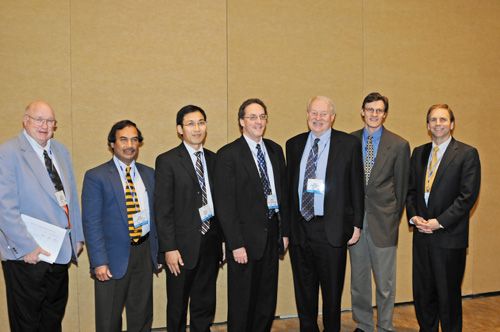
The panel from the 2008 EAS Award for Outstanding Achievements in the Fields of Analytical Chemistry session. From left to right: Gene Berry (section chair), Abdul Malik, Naijun Wu, Milton Lee, Milos Novotny, Adam Woolley, and Doug Later. (Photo courtesy of EAS.)
In a Few Words: Who Is Milton L. Lee?
The friends, colleagues, and students we interviewed for this article all provided glowing praise for the type of person Lee is and what it is like to work with or for him. This year we also asked everyone to describe Lee’s personal character or work ethic in three words. A few examples of the responses we received include brilliant, innovative, honorable, loyal, curious, dedicated, tireless, and cooperative. The three words that came up most often were: integrity, reliable, and creative.
Novotny expanded on the three words he chose. “Lee has high scientific standards and great organizational skills,” he said “He is a valuable and reliable scientific colleague.”
Richter also said a bit more than just three words about Lee’s personal character and work ethic. “He seems to have unlimited energy and ideas that need developing. He is a man of integrity and loyalty,” said Richter. “He expects a lot from those that work for him, but he also provides an example of someone who is hard-working and dedicated to his field of endeavor.”
Indeed, Lee certainly seems to exemplify a highly creative man with great integrity.
Debby MangelingsLCGC’s 2016 Emerging Leader in Chromatography, Debby Mangelings, obtained her pharmacist diploma in 2001 from the Vrije Universiteit Brussel and a PhD in pharmaceutical sciences in March 2006 from the same university.
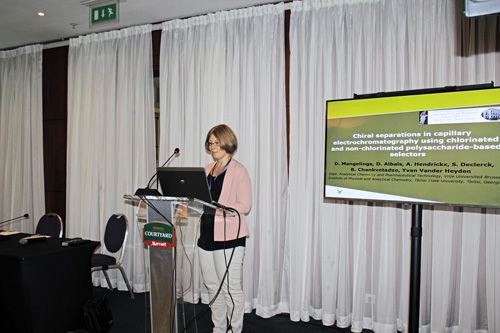
Mangelings presenting her invited lecture at the 26th International Symposium on Pharmaceutical and Biomedical Analysis which took place in Tbilisi, Republic of Georgia in July 2015.
Mangelings’s PhD supervisor was Yvan Vander Heyden, a professor in the Department of Analytical Chemistry and Pharmaceutical Technology at Vrije Universiteit Brussel, who took notice of her work during her early graduate studies. “During her master’s thesis work, which was also performed in our department, we noticed that she was a logically thinking and hard working student, so we asked her to start a PhD,” said Vander Heyden. Mangelings agreed.
After completing her PhD in 2006, with a thesis entitled “Evaluation of Capillary Electrochromatography as Chiral Separation Technique-Definition of a Generic Separation Strategy,” Mangelings became a postdoctoral fellow with the Research Foundation Flanders (FWO) within the Department of Analytical Chemistry and Pharmaceutical Technology at Vrije Universiteit Brussel. She became a part-time professor at Vrije Universiteit Brussel in 2009 and was promoted to associate professor in 2010, which is the position she holds today. In this role, Mangelings has supervised five successful doctoral students and is currently supervising five additional students who are working on their degrees.
A Focus on Chiral Separations
Mangelings’s work has focused primarily on chiral separations and the use of miniaturized separation techniques. She has focused on the definition and updating of chiral separation strategies for various modes of high performance liquid chromatography (HPLC)-including normal-phase, reversed-phase, and polar organic solvent chromatography-as well as for CE and capillary electrochromatography (CEC). Her current research efforts are focused on developing supercritical fluid chromatography (SFC) methods for chiral analyses and nonchiral analysis for drug impurity profiling, the robustness of chiral CE methods, the use of new chiral stationary phases in CEC, and the development of fingerprint chromatograms of herbal extracts using ultrahigh-pressure liquid chromatography (UHPLC) with mass spectrometry (MS) detection. The synthesis of in-capillary stationary phases, such as monoliths for both chiral and achiral separations in CEC, is another one of her interests.
More recently, Mangelings has become involved in the chemometric data analysis of chiral separation data to study systems with similar or dissimilar enantioselectivity. In CEC, she is working on the evaluation of new stationary phases, such as those with smaller particle diameters or with core-shell particles. Finally, she recently was involved in the successful chiral separation of uncommon compounds such as the boron cluster species.
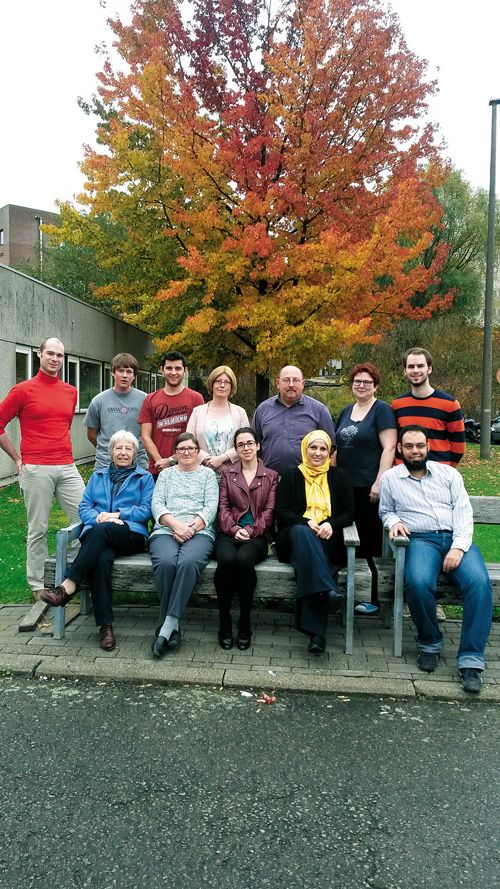
Members of the Department of Analytical Chemistry and Pharmaceutical Technology at the Vrije Universiteit Brussel (VUB). Back row, from left to right: Johan Viaene, Bart De Cock, Sven Declerck, Debby Mangelings, Yvan Vander Heyden, Peggy Verbuyst, and Andres Ceuterick. Front row, from left to right: Solange Peeters, Katrien Decq, Charlene Galea, Dima Albals, and Mahmoud Hefny Gad.
Mangelings has received two awards for her research. At the 17th International Symposium on Microscale Separations and Analysis in 2004 (HPCE 2004) held in Salzburg, Austria, Mangelings received the Applied Physical Chemistry Award of the Istvan Halasz Foundation for outstanding achievements in the field of chromatography. In 2007, she was the Laureate of the National Prize of the Belgian Society of Pharmaceutical Sciences.
Vander Heyden said that Mangelings is clearly one of the most promising experts in chiral separations.
Martin Schmid, an associate professor at the University of Graz, Austria, said that Mangelings’s work to make chiral method development more strategic and systematic is important because chiral separation behavior is difficult to predict and often remains a trial-and-error attempt-despite great advances in method development for enantioseparation in the last 20–30 years. “Mangelings’s group has made a lot of progress introducing chiral separation strategies, such as for CEC,” he said “With their help it will be easier to get positive results for enantioresolution of a broad spectrum of analytes.”
Bezhan Chankvetadze, a Professor and Director of the Institute of Physical and Analytical Chemistry at Tbilisi State University, agreed. “Based on our current understanding of chiral separations, we cannot predict separation results based on molecular descriptors of a chiral selector and screening remains the major way for achieving and optimizing enantioseparations,” said Chankvetadze. “Therefore, optimizing the existing screening strategies is very important for both academia and industry, in particular the pharmaceutical industry.”
Caroline West, an associate professor at the University of Orléans, echoed the comments of Schmid and Chankvetadze. “Mangelings’s work is definitely practical, with an intention to rationalize and simplify the strategies to achieve chiral separations with a minimum of time, effort, and costs,” West said. “She is devoted to producing something useful and easy for end-users.”
Another scientific peer, Serge Rudaz, an associate professor at the University of Geneva, made similar remarks. “Mangelings is strong in both the theoretical and practical aspects of separation science and has a keen eye for topics with a broad interest,” he said. He noted her important contributions in chiral CEC specifically, which he monitored closely during a period when his group was involved with the countercurrent approach in capillary zone electrophoresis. “It was the pioneering period for coupling electro-driven techniques with mass spectrometry,” he said. “It was difficult for all groups, therefore we were really following all contributions that could help us to have success with the hyphenation of CE and MS.”
Mangelings has also shared her work and expertise with the scientific community at large. Her publication record includes 8 book chapters and 64 manuscripts in peer-reviewed journals, and she has given 45 oral and 71 poster presentations at national and international congresses and symposia. Since 2012 she has been a member of the editorial board of Chromatographia and Acta Chromatographica.
West noted that Mangelings’s work is cited often, with a Scopus count of 770 external citations and an h-index of 15. “Among her papers are some of the most influential works on the development of generic screening strategies for chiral separations,” said West.
Teresa Kowalska, a professor in the Institute of Chemistry at the University of Silesia, is also impressed by the impact Mangelings’s expertise has had so far, despite her young age. “Mangelings’s outstanding expertise, particularly in the fields of capillary electrophoresis and capillary electrochromatography, makes her an internationally recognized leading figure, an invited speaker at many separation science conferences, and a highly demanded reviewer for multiple separation science journals,” she concluded.
Indeed, Chankvetadze stated that he enjoys Mangelings’s presentations at international conferences because they always contain solid scientific results and are well organized and clear. As a result, Chankvetadze has invited Mangelings to be a speaker at all of the international conferences he has organized in recent years. He also commended Mangelings’s work as an author and reviewer. “Mangelings greatly serves the separation science community not only as a good author, but also as a very competent and fair reviewer of submissions to international journals,” said Chankvetadze. “Knowing her ability to be a principled, fair, and punctual judge, I frequently ask her to review manuscripts for the Journal of Pharmaceutical and Biomedical Analysis, which I edit.”
Kowalska had a similar assessment of Mangelings’s work as a reviewer. “Whenever I invite her to review a manuscript submitted to a chromatography journal that I edit, Acta Chromatographica, she always accepts my invitation,” she said. “Manuscript reviews provided by Mangelings are exemplary masterpieces of competence and thoroughness, voluminous and not just critical, but appreciably educative for the manuscript authors.”
Chankvetadze said that although Mangelings is young and can still be considered an emerging scientist, she is already a well-established leader worldwide in the field of enantioseparations. “The proof of this is not only her impressive list of publications in international journals and the presentations she makes at international conferences, but also the network of PhD and master’s degree students around her at Vrije Universiteit Brussels, as well as the international collaborations she is involved in,” he said.
Chankvetadze also enjoys his own direct collaborations with Mangelings, who is a very pleasant colleague who always considers the contribution of all parties in a joint project. “She has a good ability to generate new projects and is a very constructive team player,” he said.
Kowalska anticipates that Mangelings’s career will continue in a challenging and rewarding way. “In my view, Mangelings will continue moving toward challenging and pioneering applications of selected instrumental separation techniques to solve demanding scientific problems in pharmaceutical and other life sciences,” she said.
Rudaz foresees a similarly bright future for Mangelings. “Mangelings is well qualified to be a future leader in separation science and has the intellect and skills to contribute massively to the study of chromatography and other separation techniques,” he concluded.
More About the Winners
In-depth interviews with Milton L. Lee and Debby Mangelings, focused on their research, challenges, and accomplishments, will be published in upcoming editions of our newsletter, E-Separation Solutions.
Meg L’Heureux is the managing editor of LCGC North America and Spectroscopy magazines in Iselin, New Jersey. Please direct correspondence about this article to mlheureux@advanstar.com
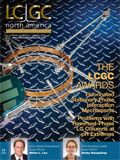
New TRC Facility Accelerates Innovation and Delivery
April 25th 2025We’ve expanded our capabilities with a state-of-the-art, 200,000 sq ft TRC facility in Toronto, completed in 2024 and staffed by over 100 PhD- and MSc-level scientists. This investment enables the development of more innovative compounds, a broader catalogue and custom offering, and streamlined operations for faster delivery. • Our extensive range of over 100,000 high-quality research chemicals—including APIs, metabolites, and impurities in both native and stable isotope-labelled forms—provides essential tools for uncovering molecular disease mechanisms and exploring new opportunities for therapeutic intervention.
New Guide: Characterising Impurity Standards – What Defines “Good Enough?”
April 25th 2025Impurity reference standards (IRSs) are essential for accurately identifying and quantifying impurities in pharmaceutical development and manufacturing. Yet, with limited regulatory guidance on how much characterisation is truly required for different applications, selecting the right standard can be challenging. To help, LGC has developed a new interactive multimedia guide, packed with expert insights to support your decision-making and give you greater confidence when choosing the right IRS for your specific needs.

.png&w=3840&q=75)

.png&w=3840&q=75)



.png&w=3840&q=75)



.png&w=3840&q=75)

